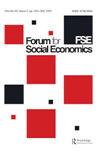{"title":"The Great Resignation in the United States: A Study of Labor Market Segmentation","authors":"T. Lambert","doi":"10.1080/07360932.2022.2164599","DOIUrl":null,"url":null,"abstract":"During 2021 and 2022, many news media outlets have reported that millions of workers in the United States have been quitting their jobs in record numbers. In a global economy rebounding from the economic downturn caused by the Covid-19 outbreak and demanding more workers, a high rate of resignations has exacerbated labor shortages and may be aggravating unemployment and underemployment rates if many workers are not participating at all in the labor force or only working part time. Many reasons have been offered to explain this ‘Great Resignation' including high day care costs for working parents that may in turn be causing the trend of lower female labor force participation;the supposed ‘liberating' experience of not working at all or to work from home instead of having to work from one's usual work place during the Covid-19 quarantine/lockdown periods;stagnant/low wages and greater job tenure uncertainty which make working less attractive and more stressful;and the feeling by many of not wanting to work further for bad bosses or management who create bad work environments so that resignation becomes a means of escape from such conditions. This article analyses data of US labor trends since 2003 and demonstrates that resignations have been trending upward in the US aggregate economy and that quit rates mostly have been trending higher within many US industries. These phenomena can be explained by the concept of labor market segmentation, high unemployment, and underemployment rates that exist even in good economic times in some industries, minority group composition within industries, wage stagnation, and type of managerial supervision. Some of these same factors help to explain labor under-utilization greater than national/aggregate rates within these industries as well. © 2023 The Association for Social Economics.","PeriodicalId":42478,"journal":{"name":"Forum for Social Economics","volume":null,"pages":null},"PeriodicalIF":0.6000,"publicationDate":"2023-01-12","publicationTypes":"Journal Article","fieldsOfStudy":null,"isOpenAccess":false,"openAccessPdf":"","citationCount":"5","resultStr":null,"platform":"Semanticscholar","paperid":null,"PeriodicalName":"Forum for Social Economics","FirstCategoryId":"1085","ListUrlMain":"https://doi.org/10.1080/07360932.2022.2164599","RegionNum":0,"RegionCategory":null,"ArticlePicture":[],"TitleCN":null,"AbstractTextCN":null,"PMCID":null,"EPubDate":"","PubModel":"","JCR":"Q4","JCRName":"ECONOMICS","Score":null,"Total":0}
引用次数: 5
美国的大辞职:劳动力市场分割研究
在2021年和2022年期间,许多新闻媒体报道说,美国数百万工人辞职的人数创历史新高。在全球经济从新冠肺炎疫情造成的经济衰退中反弹并需要更多工人的背景下,高辞职率加剧了劳动力短缺,如果许多工人根本不参加劳动力市场或只从事兼职工作,可能会加剧失业率和就业不足率。很多原因解释这个“大辞职”包括日托成本高工作的父母,反过来可能导致较低的女性劳动力的参与的趋势;所谓的“解放”的经验不工作,或者在家工作而不是工作从一个通常的工作场所Covid-19检疫/封锁时期;停滞不前/低工资和更大的工作任期的不确定性使工作缺乏吸引力和压力更大;和很多人都不想再为坏老板或管理层工作了,他们创造了糟糕的工作环境,因此辞职成了逃离这种环境的一种手段。本文分析了自2003年以来美国劳动力趋势的数据,并表明辞职在美国总体经济中呈上升趋势,并且在美国许多行业中辞职率大多呈上升趋势。这些现象可以通过劳动力市场分割的概念、高失业率和就业率不足来解释,即使在经济景气的时候,一些行业也存在这种现象、行业内的少数群体组成、工资停滞和管理监督的类型。其中一些因素也有助于解释这些行业的劳动力利用率低于全国/总体水平。©2023社会经济协会。
本文章由计算机程序翻译,如有差异,请以英文原文为准。


